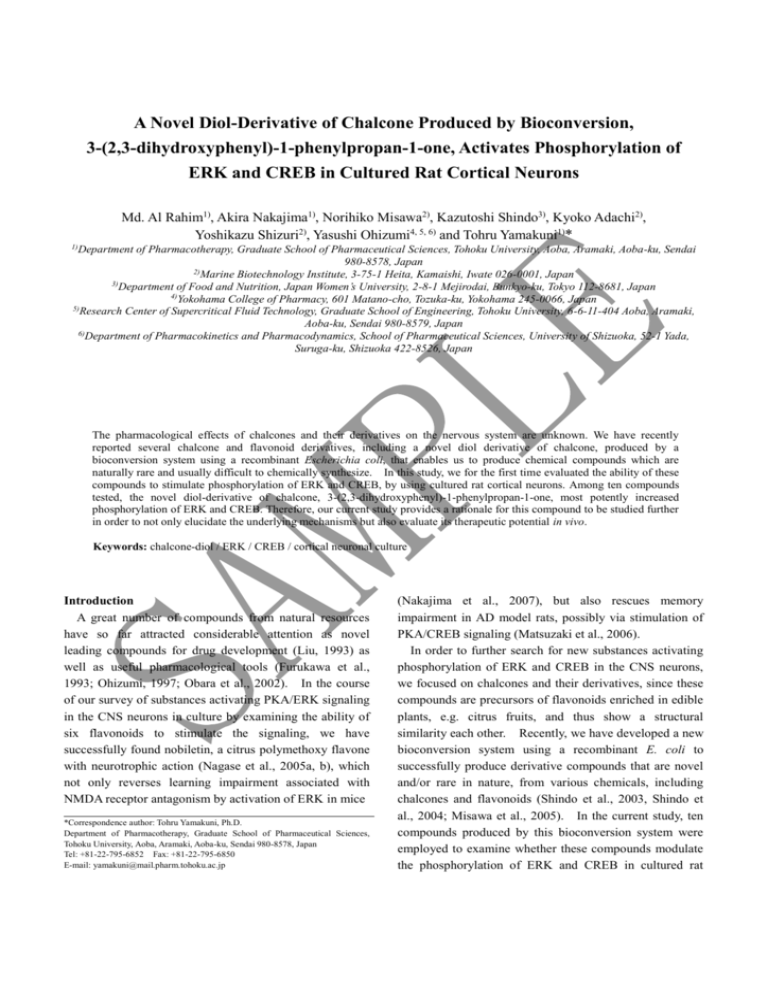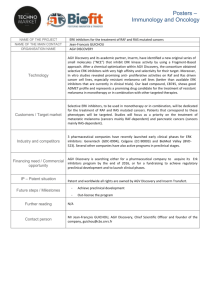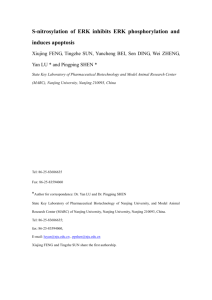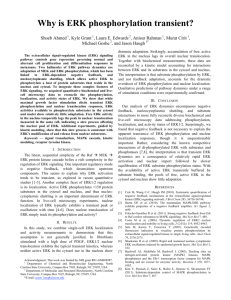Chalcone activates ERK/CREB signaling in
advertisement

A Novel Diol-Derivative of Chalcone Produced by Bioconversion, 3-(2,3-dihydroxyphenyl)-1-phenylpropan-1-one, Activates Phosphorylation of ERK and CREB in Cultured Rat Cortical Neurons Md. Al Rahim1), Akira Nakajima1), Norihiko Misawa2), Kazutoshi Shindo3), Kyoko Adachi2), Yoshikazu Shizuri2), Yasushi Ohizumi4, 5, 6) and Tohru Yamakuni1)* 1)Department of Pharmacotherapy, Graduate School of Pharmaceutical Sciences, Tohoku University, Aoba, Aramaki, Aoba-ku, Sendai 980-8578, Japan 2)Marine Biotechnology Institute, 3-75-1 Heita, Kamaishi, Iwate 026-0001, Japan 3)Department of Food and Nutrition, Japan Women’s University, 2-8-1 Mejirodai, Bunkyo-ku, Tokyo 112-8681, Japan 4)Yokohama College of Pharmacy, 601 Matano-cho, Tozuka-ku, Yokohama 245-0066, Japan 5)Research Center of Supercritical Fluid Technology, Graduate School of Engineering, Tohoku University, 6-6-11-404 Aoba, Aramaki, Aoba-ku, Sendai 980-8579, Japan 6)Department of Pharmacokinetics and Pharmacodynamics, School of Pharmaceutical Sciences, University of Shizuoka, 52-1 Yada, Suruga-ku, Shizuoka 422-8526, Japan The pharmacological effects of chalcones and their derivatives on the nervous system are unknown. We have recently reported several chalcone and flavonoid derivatives, including a novel diol derivative of chalcone, produced by a bioconversion system using a recombinant Escherichia coli, that enables us to produce chemical compounds which are naturally rare and usually difficult to chemically synthesize. In this study, we for the first time evaluated the ability of these compounds to stimulate phosphorylation of ERK and CREB, by using cultured rat cortical neurons. Among ten compounds tested, the novel diol-derivative of chalcone, 3-(2,3-dihydroxyphenyl)-1-phenylpropan-1-one, most potently increased phosphorylation of ERK and CREB. Therefore, our current study provides a rationale for this compound to be studied further in order to not only elucidate the underlying mechanisms but also evaluate its therapeutic potential in vivo. Keywords: chalcone-diol / ERK / CREB / cortical neuronal culture Introduction A great number of compounds from natural resources have so far attracted considerable attention as novel leading compounds for drug development (Liu, 1993) as well as useful pharmacological tools (Furukawa et al., 1993; Ohizumi, 1997; Obara et al., 2002). In the course of our survey of substances activating PKA/ERK signaling in the CNS neurons in culture by examining the ability of six flavonoids to stimulate the signaling, we have successfully found nobiletin, a citrus polymethoxy flavone with neurotrophic action (Nagase et al., 2005a, b), which not only reverses learning impairment associated with NMDA receptor antagonism by activation of ERK in mice *Correspondence author: Tohru Yamakuni, Ph.D. Department of Pharmacotherapy, Graduate School of Pharmaceutical Sciences, Tohoku University, Aoba, Aramaki, Aoba-ku, Sendai 980-8578, Japan Tel: +81-22-795-6852 Fax: +81-22-795-6850 E-mail: yamakuni@mail.pharm.tohoku.ac.jp (Nakajima et al., 2007), but also rescues memory impairment in AD model rats, possibly via stimulation of PKA/CREB signaling (Matsuzaki et al., 2006). In order to further search for new substances activating phosphorylation of ERK and CREB in the CNS neurons, we focused on chalcones and their derivatives, since these compounds are precursors of flavonoids enriched in edible plants, e.g. citrus fruits, and thus show a structural similarity each other. Recently, we have developed a new bioconversion system using a recombinant E. coli to successfully produce derivative compounds that are novel and/or rare in nature, from various chemicals, including chalcones and flavonoids (Shindo et al., 2003, Shindo et al., 2004; Misawa et al., 2005). In the current study, ten compounds produced by this bioconversion system were employed to examine whether these compounds modulate the phosphorylation of ERK and CREB in cultured rat cortical neurons. Here we provide the first evidence that a novel diol derivative of chalcone, 3-(2,3dihydroxyphenyl) -1-phenylpropan-1-one,potently stimulates the phosphorylation of ERK and CREB in cultured cortical neurons. Materials and methods 1. Preparations of the Tested Compounds The bphA1(2072) gene is an evolved gene shuffled between the biphenyl dioxygenase large (α subunit genes derived from polychlorinated biphenyl (PCB)-degrading soil bacteria Pseudomonas pseudoalcaligenes KF707 and Burkholderia xenovorans LB400 (Misawa et al., 2002). The tested compounds shown in Table 1 were prepared by the co-cultivation of the corresponding substrates and E. coli cells carrying bphA1(2072) along with the bphA2A3A4 genes from P. pseudoalcaligenes KF707, which encoded the small (β) subunit, ferredoxin and ferredoxin reductase of biphenyl dioxygenase, and the bphB gene coding for subsequent desaturase from strain KF707, as described previously (Shindo et al., 2003; Misawa et al., 2005). The bphC gene from strain KF707 was together used as needed (Shindo et al., 2004). As an example, compound #3, a novel chalcone-diol was prepared as follows: E. coli JM109 carrying plasmid pBS2072B, which contained bphA1 (2072) - bphA2A3A4 bphB , was grown in an LB medium containing 150 μg/ml of ampicillin (Ap) at 30°C with reciprocal shaking (175 rpm) for 6-7 h until the absorbance at OD 600 nm had reached approximately 1. Eight milliliters of this culture was inoculated into 100 ml of an M9 medium with 150 μg/ml of Ap, 1 mM of isopropyl -D-thiogalactopyranoside, 0.4% (w/v) glucose, and 10 mg of trans-chalcone (Aldrich) in a Sakaguchi flask, and co-cultivated at 30℃ with reciprocal shaking (175 rpm) for 2 days. The culture medium was extracted with ethylacetate, and the organic layer was further purified by silica gel column chromatography (hexane-ethylacetate = 4:1) to give a purified chalcone-diol (5.9 mg), as described previously (Shindo et al., 2003). 2. Cortical Neuronal Culture and Treatment Primary culture of cortical neurons was prepared as described previously with minor modifications (Nagase et al., 2005b; Matsuzaki et al., 2006). In brief, under ether anesthesia of an 18-day Sprague-Dawley (SD) rat (Japan, SLC), embryos were immediately decapitated. The brain was quickly removed, and cortex was collected in ice-cold Dulbecco’s Phosphate Buffered Saline (DPBS) under sterile conditions. The cortical neurons were dissociated according to the standard methods with SUMITOMO Nerve-Cell Culture System (SUMITOMO BAKELITE), plated on 35-mm culture dish coated with poly-L-lysine (Life Technologies) at a density of 1 x 10 6 cells/dish in Neurobasal Medium without phenol red (Gibco Co., Ltd.) containing B-27 supplement (Gibco Co., Ltd.), 500 M L-glutamine and 0.005% penicillin-streptomycin, and cultured at 37°C in a humidified atmosphere consisting of 5% CO2 and 95% air. At 4 days in vitro (D.I.V.), a half of the medium was replaced by the medium containing a mitotic inhibitor, cytosine arabinofuranoside (Ara-C), to inhibit non-neuronal proliferation. At 10-14 D.I.V., cultured cortical neurons were treated with the compounds tested, including a novel chalcone-diol, or vehicle (0.1% DMSO) in the Ara-C containing medium without B-27 supplement and L-glutamine at 100 μM concentrations for 30-min, and thereafter subjected to Western blot analysis. Table 1 List of compounds tested for the ability to stimulate ERK/CREB phosphorylation Sample ID Chemical Nomenclature 1 2-(2,3-Dihydroxyphenyl)-chroman-4-one 2 6-(4-Oxo-chroman-2-yl)-pyridine-2carboxylic acid 2-oxo-2-phenylethylester 3 3-(2,3-Dihydroxyphenyl)-1phenylpropan-1-one 4 3-Napthalen-1-yl-benzene-1,2-diol 5 3-Napthalen-2-yl-benzene-1,2-diol 6 3-Benzothiazole-2-yl-benzene-1,2-diol 7 3-Benzooxazol-2-yl-benzene-1,2-diol 8 3-Pyridin-2-yl-benzene-1,2-diol 9 3-(2,3-Dihydroxyphenyl)-indan-1-one 10 3-Imidazole-1-ylmethyl-benzene-1,2-diol Cultured cortical neurons were treated with 100 μM of each of the listed compound for 30 min and subjected to Western blot analysis as described under Experimental Procedures. 3. Cell Extract Preparation and Western Blot Analysis Cell extract preparation and Western blot analysis were conducted, as described previously (Nagase et al., 2005b; Matsuzaki et al., 2006). After treatment with tested compounds, cells were lysed with 60 μl of lysis buffer (1 mM EDTA, 1% SDS, 10 mM NaF, 10 nM calyculin, 320 nM okadaic acid, 1 μM sodium orthovanadate, 1 mM p-APMSF, 10 μg/ml pepstatin, 10 μg/ml antipain, 10 μg/ml leupeptin, 10 μg/ml chymostatin, 10 μg/ml phosphoramidon, 10 mM HEPES, pH 7.5) per 35-mm dish. Cell lysates were heated at 95°C for 5 min, sonicated and centrifuged at 14,000 r.p.m. for 20 min at 4°C to obtain the supernatant as cell extracts. Cell extracts were separated by 12.5% SDS-PAGE and transferred onto PVDF membrane. The membranes were incubated with anti-phospho-ERK (Thr202/Tyr204), anti-phospho-CREB (Ser133), anti-total ERK antibodies (1:1000, Cell Signaling Technology). OH OH O F i g . 1 . Chemica l st ruct ure of a novel chalcone-diol, 3-(2,3-dihydroxyphenyl)-1-phenylpropan-1 -one. Immunoreactive proteins were visualized by chemiluminescence as described previously (Matsuzaki et al., 2006). The band intensities were quantitatively analyzed using SCION image software. 4. Statistical Analyses Student’s t test was performed to measure the level of significance. A level of p < 0.05 was considered to be statistically significant. Results A novel chalcone-diol most potently stimulates the phosphorylation of ERK and CREB among the bioconverted compounds tested in cultured rat cortical neurons. The effects of chalcones and the derivative compounds are still unidentified in the nervous system. To examine the effects of the bioconverted derivatives of chalcone and flavonoid on the phosphorylation of ERK and a possible downstream effector, CREB, the ten compounds (listed in Table 1) were screened by assaying the activity to stimulate the phosphorylation of ERK and CREB in cultured rat cortical neurons, using Western blot analysis. Rat cortical neuronal cultures were treated with the tested compounds at 100 μM for 30 min and subjected to Western blot analysis. As shown in Fig. 2, it was observed that eight of the tested compounds failed to stimulate the phosphorylation of ERK and CREB, and some of them rather depressed the phosphorylations. The compound #4, 3-napthalen-1-yl-benzene-1,2-diol, showed a little increase in the phosphorylation of CREB, yet it was not effective enough to be studied further. On the other hand, among the compounds tested, compound #3, a no ve l d io l d e r i vat i ve o f c h alco n e, 3 -(2 ,3 dihydroxyphenyl)-1-phenylpropan-1-one (Fig. 1), only markedly increased the phosphorylation of ERK and its downstream target, CREB, in cultured rat cortical neurons (Fig. 2). The remarkable stimulatory effects of the compound on the phosphorylation of the proteins prompted us to study in more detail the pharmacological characteristics of this novel chalcone-diol in cultured cortical neurons. Currently, detail mechanistic study with this compound is under investigation. Discussion Earlier studies have reported that chalcones and their derivatives have beneficial pharmacological actions, including anti-inflammatory (Hsieh et al., 2000; Won et al., 2005), anti-pyretic (De Leon et al., 2003), anti-invasive (Mukherjee et al., 2001) and anti-proliferative (Lin et. al., 2002) activities. However, the effects of the chalcone and their derivatives on the CNS neurons have been so far unidentified. Thus, to our knowledge, this study is the first to demonstrate that the chalcone derivative activates the phosphorylation of ERK and CREB in cultured cortical neurons. The activation of ERK is required to induce nuclear translocation and the subsequent activation of RSK2, which in turn phosphorylates CREB to stimulate CRE-dependent transcription (Impey et al., 1998). Our present results evidently showed that the chalcone-diol enhanced the phosphorylation of not only ERK, but also the phosphorylation of the downstream effector, CREB, indicating a stimulatory effect of the compound on ERK/CREB signaling in the cortical neurons. Very recently, we also found that chalcone-diol stimulated CRE-mediated transcription in both cultured cortical and hippocampal neurons (data not shown). A Compounds # C 1 2 3 4 5 6 7 8 9 10 P-ERK P-CREB Total ERK B ** P-ERK (Fold of control) 5 4 3 2 1 0 C 1 2 3 4 5 6 7 8 9 10 Compounds # Acknowledgements The authors thank to Toshihiko Otomatsu of KNC Laboratories Co. for large-scale preparation of chalcone-diol. This work was supported in part by a grant-in-aid for Scientific Research from the Ministry of Education, Culture, Sports, Science, and Technology of Japan, and the grant from Takeda Science Foundation. *** P-CREB (Fold of control) 5 4 3 2 1 0 C 1 The chemical structure of chalcones consists of two aromatic rings joined by a three-carbon α,-unsaturated carbonyl system (Achanta et al., 2006). However, the chalcone-diol generated by our bioconversion system is characterized by the fact that it contains a catechol moiety in its structure, which is attached to the second aromatic ring by a saturated carbonyl system instead of an unsaturated one. Thus, based on the structural difference between this compound and the other chalcones reported so far, it may be interpreted that the presence of a saturated carbonyl system in between two aromatic rings is the unique structural feature of this chalcone-diol. In summary, this pharmacological approach combined with bioconversion led us to successfully identify a novel chalcone-diol as the agent, which act i va te s phosphorylation of ERK and CREB in the cultured cortical neurons. These results of the current study would add new dimension to and attract greater attention in the research interest of the chalcone compounds, and further pharmacological studies would give new insights into better understanding of the molecular mechanism of this novel chalcone-diol. 2 3 4 5 6 7 8 9 10 Compounds # Fig. 2. A novel chalcone-diol activates phosphorylation of ERK and its downstream target, CREB, in cultured rat cortical neurons. Shown are representative results from at least three independent experiments. Neurons plated at a density of 1 x 106 cells/35-mm dish were cultured for 10-14 days. Cells were then stimulated with ten different compounds at 100 μM for 30 min. (A) Western blot analyses were performed using anti-phospho-ERK and anti-phospho-CREB antibodies. Blots were then stripped and reprobed with anti-total ERK antibody to verify that equal amount of protein was electrophoresed in each lane. (B) Relative densitometric expressions of the phosphorylated ERK and CREB were normalized to the total ERK. Values are means ± S.E.M. (n = 3). C: control. **p < 0.01, ***p < 0.001 vs control. References Achanta, G., Modzelewska, A., Feng, L., Khan, S.R. and Huang, P. (2006): A boronic- chalcone derivative exhibits potent anticancer activity through inhibition of the proteasome. Mol. Pharmacol., 70, 426-433. De Leon, E.J., Alcaraz, M.J., Dominguez, J.N., Charris, J. a n d T e r e n c i o , M . C . ( 2 0 0 3 ) : 1-(2,3,4trimethoxyphenyl)-3-(3-(2-chloroquinolinyl))-2-propen1-one, a chalcone derivative with analgesic, anti-inflammatory and immunomodulatory properties. Inflamm. Res., 52, 246-257. Furukawa, K.I., Sakai, K., Watanabe, S., Maruyama, K., Murakami, M., Yamaguchi, K. and Ohizumi, Y. (1993): Goniodomin A induces modulation of actomyosin ATPase activity mediated through conformational change of actin. J. Biol. Chem., 268, 26026-26031. Hsieh, H.K., Tsao, L.T., Wang, J.P. and Lin, C.N. (2000): Synthesis and anti-inflammatory effect of chalcones. J. Pharm. Pharmacol., 52, 163-171. Impey, S., Mark, M., Villacres, E.C., Poser, S., Yano, S., Wayman, G., Deloulme, J.C., Chan, G. and Storm, D.R. (1998): Crosstalk between ERK and PKA is required for Calcium stimulation of CREB-dependent transcription and ERK nuclear translocation. Neuron 21, 869-883. Lin, Y.M., Zhou, Y., Flavin, M.T., Zhou, L.M., Nie, W. and Chen, F.C. (2002): Chalcones and flavonoids as anti-tuberculosis agents. Bioorg. Med. Chem., 10, 2795-2802. Liu, J., (1993): FK506 and cyclosporin: Molecular probes for studying intracellular signal transduction. Trends Pharmacol. Sci., 14, 182-188. Matsuzaki, K., Yamakuni, T., Hashimoto, M., Haque, A.M., Shido, O., Mimaki, Y., Sashida, Y. and Ohizumi, Y. (2006): Nobiletin restoring beta-amyloid-impaired CREB phosphorylation rescues memory deterioration in Alzheimer`s disease model rats. Neurosci. Lett., 400, 230-234. Misawa, N., Nakamura, R., Kagiyama, Y., Ikenaga, H., Furukawa, K. and Shindo, K. (2005): Synthesis of Vicinal Diols from Various Arenes with a Heterocyclic, Amino or Carboxyl Group by Using Recombinant Escherichia coli Cells Expressing Evolved Biphenyl Dioxygenase and Dihydrodiol Dehydrogenase Genes. Tetrahedron 61, 195-204. Misawa, N., Shindo, K., Takahashi H, Suenaga H, Iguchi K, Okazaki H, Harayama S, and Furukawa K (2002) Hydroxylation of various molecules including heterocyclic aromatics using recombinant Escherichia coli cells expressing modified biphenyl dioxygenase genes. Tetrahedron 58, 9605-9612. Mukherjee, S., Kumar, V., Prasad, A.K., Raj, H.G., Bracke, M.E., Olsen, C.E., Jain, S.C. and Parmar, V.S. (2001): Synthetic and biological activity evaluation studies on novel 1,3-diarylpropenones. Bioorg. Med. Chem., 9, 337-45. Nagase, H., Omae, N., Omori, A., Nakagawasai, O., Tadano, T., Yokosuka, A., Sashida, Y., Mimaki, Y., Yamakuni, T. and Ohizumi, Y. (2005a): Nobiletin and its related flavonoids with CRE-dependent transcription-stimulating and neuritegenic activities. Biochem. Biophys. Res. Commun., 337, 1330–1336. Nagase, H., Yamakuni, T., Matsuzaki, K., Maruyama, Y., Kasahara, J., Hinohara, Y., Kondo, S., Mimaki, Y., Sashida, Y., Tank, A.W., Fukunaga, K. and Ohizumi, Y. (2005b): Mechanism of neurotrophic action of nobiletin in PC12D cells. Biochemistry 44, 13683–13691. Nakajima, A., Yamakuni, T., Matsuzaki, K., Nakata, N., Onozuka, H., Yokosuka, A., Sashida, Y., Mimaki, Y. and Ohizumi, Y. (2007): Nobiletin, a citrus flavonoid, reverses learning impairment associated with NMDA receptor antagonism by activation of ERK signaling. J Pharmacol. Exp. Ther., 321, 784-790. Obara, Y., Aoki, T., Kusano, M. and Ohizumi, Y. (2002): -Eudesmol induces neurite outgrowth in rat pheochromocytoma cells accompanied by an activation of mitogen-activated protein kinase. J. Pharmacol. Exp. Ther., 301, 803-811. Ohizumi, Y. (1997): Application of physiologically active substances isolated from natural resources to pharmacological studies. Jpn. J. Pharmacol., 73, 263-289. Shindo, K., Kagiyama, Y., Nakamura, R., Hara, A., Ikenaga, H., Furukawa, K. and Misawa, N. (2003): Enzymatic synthesis of novel antioxidant flavonoids by Escherichia coli cells expressing modified metabolic genes involved in biphenyl catabolism. J. Mol. Catal. B: Enzym., 23, 9-16. Shindo, K., Osawa, A., Nakamura, R., Kagiyama, Y., Sakuda, S., Shizuri, Y., Furukawa, K. and Misawa, N. (2004): Conversion from arenes having a benzene ring to those having a picolinic acid by simple growing cell reactions using Escherichia coli that expressed the six bacterial genes involved in biphenyl catabolism. J. Am. Chem. Soc., 126, 15042-15043. Won, S.J., Liu, C.T., Tsao, L.T., Weng, J.R., Ko, H.H., Wang, J.P. and Lin, C.N. (2005): Synthetic chalcones as potential anti-inflammatory and cancer chemopreventive agents. Eur. J. Med. Chem., 40, 103-12.








